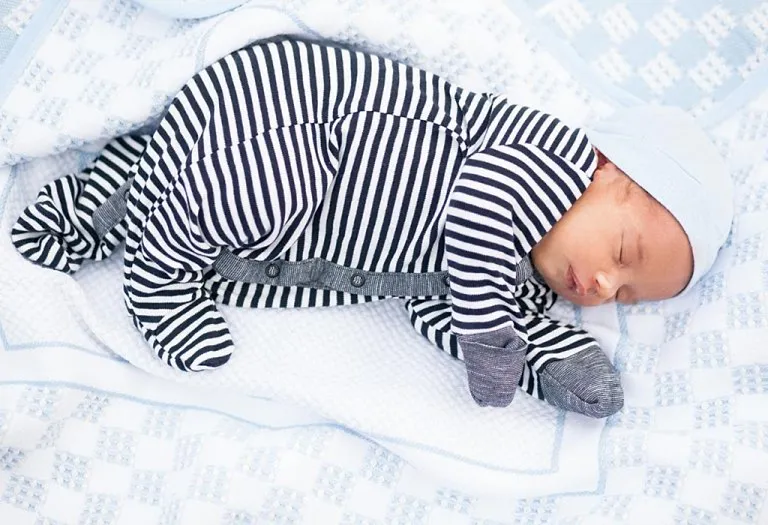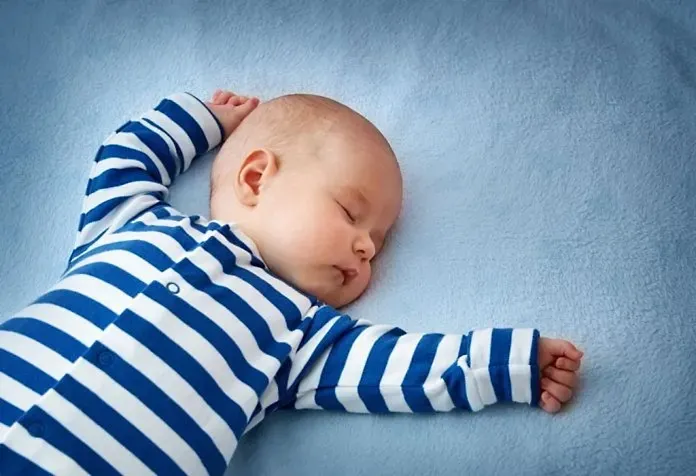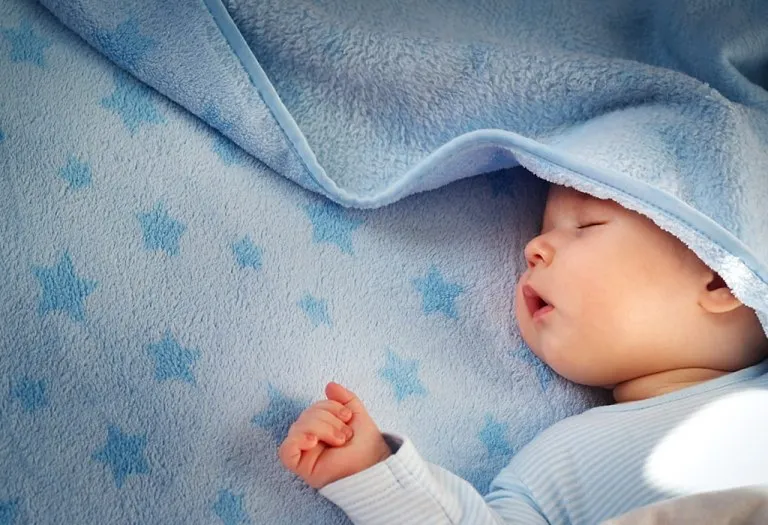Baby Sleeping on Side – Risks and Precautions

- Why is it Important That Your Baby Sleeps in the Right Position?
- Is Sleeping on the Side Safe for Babies?
- What If the Baby is Not Comfortable Sleeping on His Back?
- Precautions to Take to Prevent the Baby From Side-Sleeping
- When Can Babies Sleep on Their Side?
- What if Your Baby Rolls Over to Its Side While Sleeping?
- FAQs
When you have a baby, everything, right from eating to sleeping, can have areas of concern. Some believe that a baby is supposed to lie on his back or stomach, while others claim that sleeping on the side is the best. In this article, we answer these questions, among many others. Can newborns sleep on their side? Read on to know if it is safe for a baby to sleep on his side. Ensuring your baby’s safety and well-being during sleep is crucial, as proper sleeping positions can significantly impact their health and development. We’ll explore the best practices and guidelines recommended by pediatricians to help you make informed decisions.
Why is it Important That Your Baby Sleeps in the Right Position?
SIDS or Sudden Infant Death Syndrome refers to the sudden death of children who are under a year of age. SIDS usually occurs as a direct result of fatal sleeping accidents in infants, so it is extremely important to ensure that your child uses a safe sleeping pattern. SIDS mainly occurs when the baby is sleeping, too. Therefore, it is imperative that the child always sleeps in the right position.
Is Sleeping on the Side Safe for Babies?
Can a baby sleep on one side? No- sleeping on the side is not a safe option for children, as it can directly lead to a number of health conditions in the child.
1. Harlequin Colour Change
In this condition, the side which the baby is asleep on changes colour to pink or red, while the other half remains unaffected (1). There is always a clear demarcating line that runs through the centre of the child’s body, with either side coloured markedly differently. The sleeping side will be a bright pink or red, while the other side will be normal. This occurs when the child sleeps on his side for hours. However, it is to be noted that even though it may look alarming, this condition does not have any ill effects on the child. The condition is a benign one, and the colours fade away in a matter of minutes after switching the side of the baby. This condition is thought to occur due to gravity affecting the blood flow in the immature blood vessels of the child, causing accumulation of red blood cells near the skin.
Treatment
No treatment is required for this condition, as the colours fade away in minutes after the position of the child is changed.
2. Flatheads
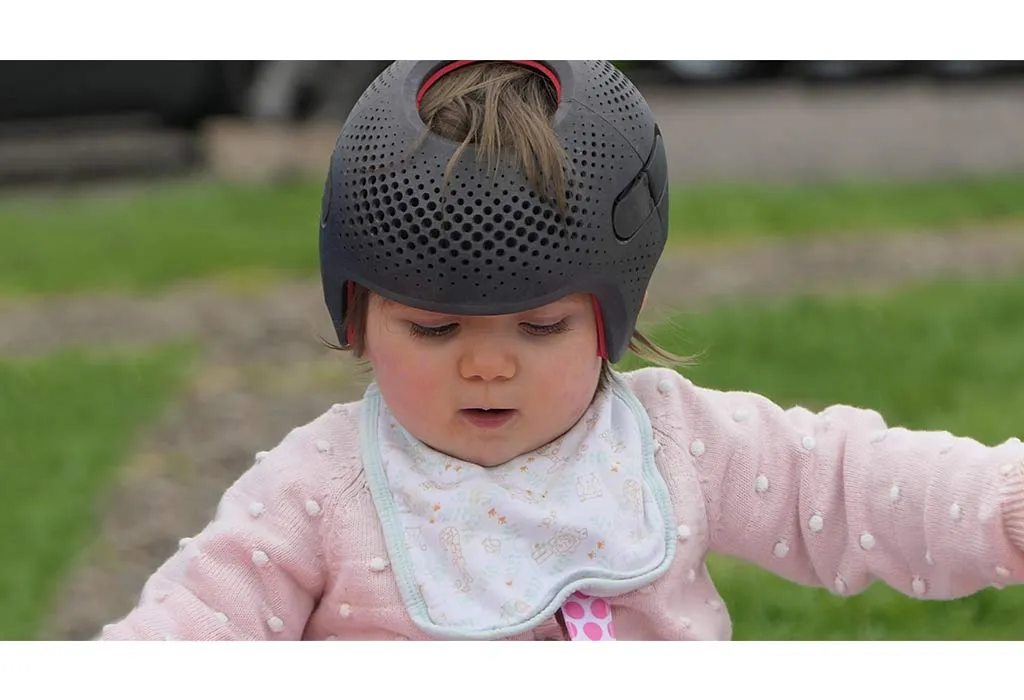
At a young age, the skull of the child is soft and malleable. This allows the brain to grow and expand, and the skull expands at the same rate too. Flatheads occur when pressure builds up at some point of the skull, causing it to go concave or flatten, or even sink inwards. This can happen if the child is placed in the same position repeatedly so that the contact area on the head is the same (2). Flatheads can occur in children even if the child has been sleeping straight, but his head was turned to the side. The improper shape of the skull may result in the brain being unable to expand, leading to stunted brain growth.
Treatment
The treatment consists of using braces called baby helmets to correct the problem. These are manufactured by certified manufacturers or hospitals and help reposition the child’s skull.
3. Torticollis
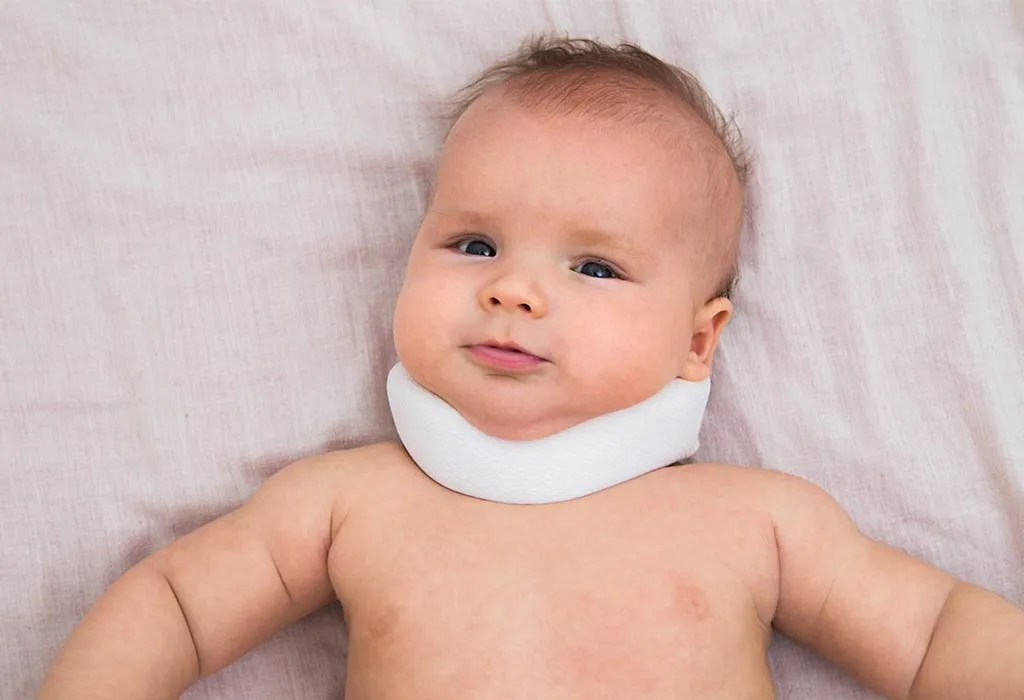
According to the Cleveland Clinic, Torticollis is characterised by the abnormal tilting of the neck of the child in one direction, due to the severe shortening of sternocleidomastoid muscle that connects the lateral side of the head to the clavicle (3). Since the muscles of the child are still tender and growing, they may be affected and shorten due to the repeated sleeping on the side or even turning of the head.
Treatment
The stiffness in the muscles of the child can be released via physical therapy or wearing a recovery harness. The harness is usually wrapped around the body of the baby and has a soft pad near the neck. This pad effectively pushes the head in the opposite direction, which gradually brings the neck to the normal position.
4. Risk of Choking
Torsion is created in the windpipe, which makes breathing difficult for the child. In some cases, regurgitated food can get accumulated near the tracheal opening, and this results in another choking hazard. Tummy sleeping is more likely when the baby sleeps on his side, and this can increase the risk of SIDS (4).
Treatment
There is no treatment for this- the best thing to do is to prevent your child from sleeping on his side.
What If the Baby is Not Comfortable Sleeping on His Back?
This is not about the comfort of the child- safety is of a higher priority, compared against comfort. You have to make your baby get used to sleeping on his back, by encouraging him to sleep in the right posture. This can be done by making him sleep on his back from an early age. This way, the child gets used to sleeping like that even if he is not comfortable with the position.
Precautions to Take to Prevent the Baby From Side-Sleeping

Some of the precautions to be taken if baby sleeps on side include:
1. Place Your Baby on the Back
This is an easy way to ensure that your child does not side sleep. Just make sure that you place him on his back when you put him to sleep, whether it be his crib or his cradle. This position also reduces the chances of upper respiratory infections occurring in the child.
2. Remove Unnecessary Support Structures
In many cribs or beds, it is found that there are items which don’t benefit the baby in any way. These include home pillows and even crib bumpers, which can negatively affect the sleeping position of the child.
3. No Sleep Positioners
Most sleep positioners or wedges are designed to ensure that your child sleeps on his side, which is not a good sleeping position. Even if the positioner helps the child sleep on his back, it must still be avoided- they have been proven to pose a suffocation hazard to the children.
4. Reduce Swaddling
Swaddling creates a cylindrical surface around the baby, which makes it easy for him to roll over in his sleep. Therefore, you must ensure that swaddling is reduced- it also increases the risk of SIDS.
5. Change Up the Positions
To reduce the risk of flatheads in children, switch the position of his head every alternate right. Shift his head to the left and right at night alternatively, when he lies on his back.
When Can Babies Sleep on Their Side?
For the first year of a baby’s life, it is essential that they only lie on their back. This is because the baby’s oesophagus, trachea, and breathing mechanism are still developing and are most secure when the baby sleeps on their back. Sleeping on the back is recommended by pediatricians and health experts to reduce the risk of Sudden Infant Death Syndrome (SIDS), which is a significant concern during the early months.
After the first year, the oesophagus, trachea, and breathing mechanisms are more developed. At this stage, it becomes safer for the baby to sleep on their side. Transitioning to side sleeping after the first year can be done gradually, ensuring that the baby is comfortable and adapts well to the new position.
In short, while side sleeping is not recommended for newborns, it can be a safe option after the first year when the baby’s respiratory system is more mature.
What if Your Baby Rolls Over to Its Side While Sleeping?
Newborns sleeping on the side have to be absolutely avoided, so you must keep an eye on the child during the first year to check if he rolls over in his sleep. Baby sleeping on the side in 3 months is still bad- it is only around 6 months of age that the muscles get sufficiently strong enough to support the child lying on his tummy. When the child rolls over on his own, it means that the risk of him choking during sleep is low (5). However, newborns rolling to the side while sleeping should not be allowed to happen below the age of six months.

FAQs
1. Are there any signs that my baby is ready to sleep on their side?
Some signs that your baby might be ready to sleep on their side include increased control over head and neck movements, the ability to roll over consistently, and general developmental milestones appropriate for their age. It’s essential to observe these signs and consult with your pediatrician before making any changes to their sleep position.
2. Can using sleep positioners help my baby sleep on their side safely?
Sleep positioners are not recommended for preventing infant sleeping on side as they can pose a risk of suffocation and other hazards. The American Academy of Pediatrics advises against using any products that claim to prevent SIDS or aid in maintaining a specific sleep position. Instead, focus on creating a safe sleep environment and consult with your pediatrician for the best practices.
Sleeping on the side is not safe for children below the age of 12 months, and is an unsafe practice. Only after a year of development do the muscles and internal organs of the child get strong enough to lower the risk of choking, so the baby must not be allowed to lie on his tummy or side during the first year of its life.
References/Resources:
1. Tang. J, Bergman. J, Lam. J; Harlequin colour change: unilateral erythema in a newborn (CMAJ); National Library of Medicine; https://www.ncbi.nlm.nih.gov/pmc/articles/PMC2988569/; November 2010
2. Preventing flat heads in babies who sleep on their backs (Paediatrics & Child Health); National Library of Medicine; https://www.ncbi.nlm.nih.gov/pmc/articles/PMC2805996/; December 2001
3. Torticollis; Cleveland Clinic; https://my.clevelandclinic.org/health/diseases/22430-torticollis
4. Sudden Infant Death Syndrome (SIDS); Nemours Kids Health; https://kidshealth.org/en/parents/sids.html
5. Safe Sleep; NCH Safe & Healthy Children’s Coalition of Collier County; https://safehealthychildren.org/safe-sleep-resources
6. Plagiocephaly (Flat Head Syndrome); Cleveland Clinic; https://my.clevelandclinic.org/health/diseases/10691-plagiocephaly-flat-head-syndrome
7. Swaddling: Is it Safe for Your Baby?; American Academy of Pediatrics; https://www.healthychildren.org/English/ages-stages/baby/diapers-clothing/Pages/Swaddling-Is-it-Safe.aspx
Baby Sleeping on Tummy
Baby Sleeping Positions
Bad Sleeping Habits for Baby
Ways to make Baby Sleep in Night
Was This Article Helpful?
Parenting is a huge responsibility, for you as a caregiver, but also for us as a parenting content platform. We understand that and take our responsibility of creating credible content seriously. FirstCry Parenting articles are written and published only after extensive research using factually sound references to deliver quality content that is accurate, validated by experts, and completely reliable. To understand how we go about creating content that is credible, read our editorial policy here.







